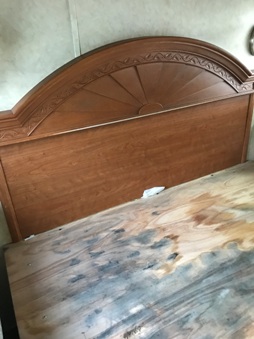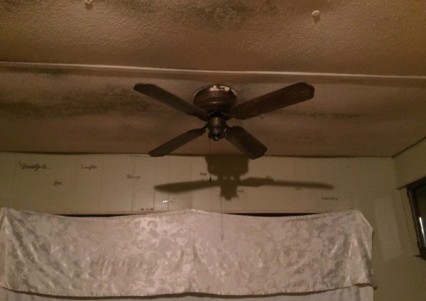Find a Mold Specialist Now
Click or Call, Toll-Free 24/7
Mold In Mobile Homes
For mobile homes, uncontained water can be the kiss of death. For mold to grow and reproduce, it needs both a food source and a moisture source. The food source has to be something organic; examples would be wood, paper, latex carpet backing, or dust and dirt. The moisture can be liquid water as in a puddle, higher than normal humidity, or just damp materials. All homes contain organic materials, so the only thing that will inhibit or promote mold growth is the amount of uncontained moisture or dampness that is present.
Health Effects of Mold Exposure
- Asthma attacks – airways become swollen and the muscles around the airways contract
- Sneezing and/or runny nose
- Acute respiratory issues – commonly defined as COPD
- Acute bronchitis – bronchial tubes become inflamed causing a shortness of breath
- Eye irritation – membranes around the whites of the eyes become inflamed (“red eye”)
- Eczema – itchy, dry patches of skin that usually appear on the hands, neck, face, and legs
Causes of Mold In Mobile Homes
Mobile homes are constructed quickly in an assembly line fashion. They usually have a steel frame to support the floor. On this steel frame floor joists (many times 2x6’s instead of the 2x12’s used in conventional home construction) are installed and then a layer of plywood or oriented strand board (OSB) is screwed down. Many times carpet and vinyl floor coverings are installed prior to the walls being built. Most interior walls are made with 2x2 studs, covered with paneling or drywall.
The style of construction can result in a more serious water damage timeline. Materials can be affected quicker and more severely by a water intrusion. OSB will swell quicker, carpet under walls can get wet and it is very hard to dry because of the difficulty of getting airflow to it. Mobile homes are designed to withstand flexing during the home’s delivery or relocation. The following are just some of the situations to look for to avoid water damage:
Condensation – Encourage circulation and/or ventilation of indoor air by using exhaust fans in kitchens and bathrooms to reduce humidity levels during cooking, washing, and bathing. Most mobile homes use propane gas in stoves and water heaters. Open flames create hydrogen as a by-product of combustion. This extra hydrogen combines with oxygen in the air and results in water vapor that can lead to condensation if not properly vented out of the home.
Lack of Insulation – Most mobile homes are not insulated as heavily as conventional homes. This lesser R-factor can lead to mold growth due to increased humidity levels, especially when outside temperatures are higher and AC units are working to keep the interior of the home cooled.
Roof Leaks – Your roof should be considered your mobile home’s first line of defense against water intrusion and mold growth. There are numerous issues that may develop with the roof of your mobile home.
- Roof coatings are known to crack and stretch over their lifetime. A problem with the coating may allow water to penetrate the membrane on the roof.
- Caulking around vents on the roof can break down and create gaps that allow water to enter the home.
- Flying debris and tree branches are common culprits when it comes to roof damage on mobile homes. What may appear to be a small dent will often be a small crack in the roof. Even a small crack can allow a lot of water to enter the home.
General Water Leaks – Any type of water intrusion over time adds up to a major problem. Things like faucet leaks, supply line issues, toilet mountings, washer hoses, etc.
Symptoms of Mold Exposure in Mobile Homes
Keep these symptoms in mind as sort of a personal reminder that something besides a common cold may be affecting you or a family member:
- Skin Rash – you don’t have to come into direct contact with mold to develop a skin rash; just breathing in mold spores and fumes can result in a rash.
- Irritation to Eyes – mold can cause eyes to water and become red. You may think the cause is seasonal allergies when a mold issue is the culprit.
- Listlessness – a feeling of being overly tired day after day even if you seem to be getting an adequate amount of sleep.
- Headaches – breathing in mold can result in headaches to people with sensitivities to mold and mold spores.
- Sore Throat – difficulty swallowing or hoarseness when talking can indicate you have been exposed to mold; sensitive membranes can become irritated by mold spores.
- Runny Nose or Stuffy Sinuses – you may think you are catching a cold but this symptom can also be a result of mold exposure.
How To Remove Mold From Mobile Homes
 Mold on bed in mobile home
Mold on bed in mobile homeWhenever mold is found in any home, it doesn’t really matter what type of mold it is. Whether you own a conventional construction home, a manufactured home, or mobile home, if you discover mold, it needs to be removed, not just “killed” or covered over with mold or stain blockers. Many people think that they are mold removal experts and by merely wiping away or sealing the visible mold with a sealant or paint that they have solved their mold problem. They are wrong! Mold, and most of the materials affected by mold, need to be systematically removed, bagged, and properly disposed of.
The first step in any mold remediation should be the elimination of any water source or leak. If you don’t stop the water, you can’t stop the mold! Mold is everywhere in nature. Your home is never “mold free”. It is only when the concentrations of mold inside are greater than what is “natural” in your particular environment that mold becomes an issue for most people. So you need to locate the mold’s water source and eliminate it.
For the next step, you must establish containment of the area or areas where the mold problem is. Setting up plastic barriers to seal any affected areas is necessary to control the movement of mold spores and also to prevent the possibility of cross-contamination into other unaffected areas. A negative air machine, or HEPA air scrubber, should be employed both inside and outside of the affected area(s) to help “wash” the air during the removal process. This is because the very act of disturbing the mold will cause the spores to become airborne and easily spread to other areas. In addition to the negative air machines you need to place a dehumidifier and one or two air movers inside the containment area. These will be used to dry down any wet structural materials and also “stir” the air, making the negative air machines more efficient at collecting any displaced mold spores.
At this point you are almost ready to remove the mold and any affected materials. But first it’s time to put on personal protective clothing and respirators. Tyvek suits, latex gloves (taped to the sleeves of the suit to seal the cuffs), and eye protection goggles (not just safety glasses). Also anyone working to remove mold should wear a respirator with at least N-95 rated cartridges. This is the recommendation of the National Institute for Occupational Safety and Health (NIOSH).
Disposal, Cleaning & Treatment
Once you have removed the mold and the mold-affected materials, you need to dispose of them. Everything should be placed in plastic bags and the bags sealed BEFORE being removed from the contained area. Use special care not to puncture any of the bags.
A high efficiency particulate air (HEPA) vacuum should be used to vacuum up as much dirt and debris as possible. Then damp wipe the entire inside area of the containment chamber. Use an antimicrobial detergent in water and a clean rag. Never re-dip a rag in the solution. When the first rag is dirty, get a new rag to moisten. Do this once a day for three days. And don’t forget to wipe down the inside of the plastic you used for containment.
Final Thoughts
Mold remediation is a complicated process. In most cases you are better off seeking professional help. Remediation specialists have the training, experience, and equipment to successfully remove mold from homes and buildings. We have a list of qualified professionals in your area that will provide you with a free, no-obligation inspection. And you know what they say, “If it’s free, it’s for me!”
Return From Mold In Mobile Homes To Our Damage From Mold Page
Written by Mark Huey.
Privacy Policy Terms and Conditions Accessibility Do Not Sell My Information Disclaimer Contact Us





